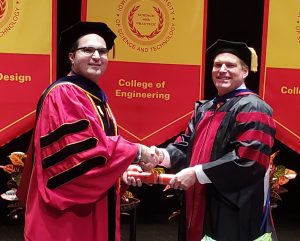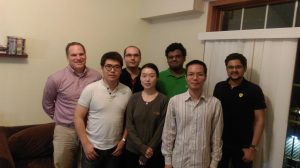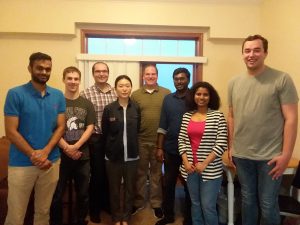Cameron MacKenzie | Vita | Research | Publications | Presentations | Thesis Supervision | Outreach | Students
Thesis Supervison
I have been fortunate to work with several wonderful Ph.D. students and master’s students. Here are descriptions of the students’ current work. This page will be updated as students finish their theses and dissertations.
Ph.D. Dissertation
 Sequential decision making and simulation-optimization for the design of complex engineering systems
Sequential decision making and simulation-optimization for the design of complex engineering systems
Ramin Giahi created a novel simulation-based design platform to determine the optimal design of engineered systems. He developed resilient, reliable, and flexible design solutions that account for system uncertainties with the optimization algorithm. Optimizing the design of complex engineered systems occurs within 4 contexts: (i) designing a resilient wind turbine system for risk-averse decision makers (published in Computers & Industrial Engineers), (ii) improving the reliable design of airfield concrete pavement, (iii) incorporating flexibility into the design of a hybrid renewable energy system (conference paper here), and (iv) finding the optimal policy for multistage designs using reinforcement learning. This dissertation proposes decision-making frameworks for engineering design problems that use Monte Carlo simulation. Ramin’s research filled a gap in engineering system design by proposing static and sequential decision-making frameworks that use simulation-optimization techniques to optimize design.
Iowa State M.S. Theses
An analysis of U.S. billion-dollar natural disasters
The National Oceanic and Atmospheric Administration (NOAA) records every natural disaster that has caused at least $1 billion in economic damages in the United States. The average annual cost of natural disasters has increased from approximately $35 billion in 1980 to $300 billion in 2017. Charchit Shukla forecasts the cost of natural disasters by fitting probability distributions to the historical cost of billion-dollar disasters in NOAA’s dataset. His thesis models the cost of natural disasters based on all weather-related disasters that exceed $1 billion since 1980 and based only on disasters in the past 20 years. The model forecasts the annual expected cost of disasters to be $52 billion if all disasters are used and $91 billion if only the most recent disasters are included in the model. His paper for the IISE annual meeting was awarded the best paper in the Engineering Economy track in 2020.
Optimizing strategies to mitigate risk in a supply chain disruption
Steve Paul developed an optimization model to help a firm determine the best strategies to use to mitigate the risk from a severe supply chain disruption. His thesis expanded my previous work that simulated the supply chain disruption after the 2011 Japanese tsunami. Steve used Bayesian optimization to maximize the expected profit of a firm, where the expected profit is calculated using simulation. This is one of the first papers to integrate simulation, optimization, and supply chain risk management.
A value-focused thinking approach to measuring community resilience
Resilience generally refers to the ability of a community or system to withstand and recover from a disruption, but specific definitions and measurements can vary widely from researcher to researcher. Rohit Suresh proposed to measure community resilience based on a value-focused thinking approach. Rohit outlined an objectives hierarchy that begins with a community decision maker’s fundamental values or objectives: social, economic, infrastructure, environmental, resource, and functionality of critical services. Each of these six objectives is further broken down into measurable attributes that focus on specific outcomes that a decision maker would like to achieve or avoid if a disruption occurs. Value functions can be used to assess the contribution of each attribute toward overall community resilience. Rohit received the Student Merit Award from the Security and Defense Specialty Group in the Society for Risk Analysis.
Simulating severe supply chain disruptions with multiple suppliers and firms
Global supply chains are susceptible to disruption, and disruptions in one part of the world can lead to supply chain problems for companies around the world. Kevin Korniejczuk’s creative component analyzed a model of severe supply chain disruptions where several suppliers encounter inoperable facilities, resulting in potential changes for firms that purchase from those suppliers. The simulation is based on one my previous papers and extended to several key suppliers and firms in the automotive, electronics, gaming, camera, and chemical industries. The results demonstrate that on average all industries are able to meet almost 100% of demand during the simulation; however, individual firms my suffer heavily and lose customers to other firms. Undergraduate researchers Snow Bai and Andre Fristo contributed to the research for this creative component.
An analysis of using online testing modules in engineering economics
Vrishtee Rane analyzed the effectiveness of using online testing modules for an large-course engineering economics. As part of a Miller Faculty Fellowship Program, I designed online testing modules for IE 305 Engineering Economics. The online testing modules consisted of randomly selected questions that a student could take as many times as he or she wished until he or she passed the testing module. Vrishtee analyzed the student performance on these online testing modules. Student survey results indicated that most students favored the online testing assessment method. Students learned from their mistakes, and their performance improved by taking the test multiple times. Vrishtee compared the performance of students assessed using traditional methods with those students assessed with the online testing modules. Overall, students earned better grades using the online testing modules than the students using in-class exams. This paper is published in The Engineering Economist.
A multiple decision-maker approach to allocating resources to prepare and respond to major disruptions
Brandon Landowski designed a model for disaster preparedness that incorporates four different decision makers: the federal government, a state government, a private sector company, and non-governmental organization (NGO). Each decision maker can allocate resources to prepare and respond to a major disruption but the decision makers’ objectives, budgets, and constraints are different. The model is applied to Hurricane Katrina in New Orleans, where the state of Louisiana is the state government decision maker, the electric utility represents the private sector company, and the Red Cross represents the NGO. Results from the application illustrate that there is likely double spending and overspending in some industries in the impacted economic region, and shared decision making between decision makers is highly encouraged. Shared decision maker allows for a greater benefit to the region than when the federal government acts alone.
 A resource allocation model for deep uncertainty (RAM-DU), with application to the Deepwater Horizon oil spill
A resource allocation model for deep uncertainty (RAM-DU), with application to the Deepwater Horizon oil spill
Lei Yao presented a new method for allocating resources when there is deep uncertainty. Deep uncertainty refers to problems with epistemic uncertainty in which the decision maker or analyst has very little information, data are not available, and different mathematical models to describe the system may be possible. The new model for allocating resources with deep uncertainty (RAM-DU) incorporates different types of uncertainty (e.g., parameter, structural, and model uncertainty) and can consider every possible model and different probability distributions and different futures. Instead of identifying a single optimal allocation, RAM-DU recommends an interval solution of allocation amounts. Lei applied RAM-DU to determining how much should be allocated to prepare and respond to a Deepwater Horizon-type oil spill.
What does decision making with intervals really assume: The relationship between the Hurwicz decision rule and prescriptive decision analysis
Decision analysts sometimes argue whether probabilities should be used for uncertainties in which little information or data is available. One non-probabilistic way to make a decision is the Hurwicz rule in which a decision maker balances between the worst (pessimistic) and best (optimistic) output. In his master’s thesis, Sarat Sivaprasad mathematically showed that the Hurwicz decision rule results in the same optimal alternative as with three other cases: (i) an expected-value decision maker who assumes a triangle distribution; (ii) an expected-value decision maker who assumes a beta distribution; and (iii) an expected-utility decision maker who uses an exponential utility function and assumes a uniform distribution. This work is important because it raises a question of whether a decision maker who is using an non-probabilistic method such as the Hurwicz rule to make a decision is really doing anything different than a decision maker who follows the rules of subjective expected-utility decision making This paper is published in the journal Decision Analysis.
Active shooter situations: An agent-based model of civilian response strategy
Alex Stewart assessed the risk of active shooters by developing an influence diagram (or Bayesian belief network) and designing an agent-based model and simulation of an active shooter situation in a school. The agent-based simulation focused on examining the effect of three parameters: (i) how quickly civilians respond to the situation, (ii) the time it takes law enforcement to arrive on the scene, and (iii) the civilian response strategy (running or hiding). The simulation found that the best civilian response strategy was for some civilians to hide and some civilians to run. The model predicts that reducing response time by a minute for law enforcement reduces the civilian casualties by about 10-15%. Civilians responding more quickly reduces the number of casualties by about 5-7%.
Estimating production losses from disruptions based on stock market returns: Applications to 9/11 attacks, the Deepwater Horizon oil spill, and Hurricane Sandy
Aditya Pathak designed a new method to assess the economic consequences or production losses from disruptions. He used data from the Bureau of Economic Analysis to model the relationship between production data for each industry in the economy and several stock market price indices (e.g., an oil and gas index, a transportation index). The model then uses the actual stock market returns in the weeks follow a disruptive event to estimate the production losses or economic consequences from the event. He developed both a deterministic model for all of the industries or sectors in the economy and a stochastic model that specifically accounts for the correlation among industries. He applied these models to three recent disruptions: the 9/11 attacks, the Deepwater Horizon oil spill, and Hurricane Sandy. His research estimates that the 9/11 attacks resulted in $123 billion in production losses, the Deepwater Horizon oil spill in $105 billion, and Hurricane Sandy in $51 billion.
Quantitative models for supply chain risk analysis from a firm’s perspective
Arun Vinayak developed quantitative models to help firms assess their risk and measure the effectiveness of suppliers. He developed a probabilistic model to assess to what extent customers returning to a business after a disruption would affect a firm’s recovery. A paper on this research appears as a book chapter in Supply Chain Risk Management: Advanced Tools, Models, and Developments. The second part of his thesis combined value-focused thinking with Supply Chain Operations Reference (SCOR) metrics to measure the effectiveness of suppliers for a firm. This work can help a firm assess new suppliers and evaluate current suppliers.
Demand forecasting and decision making under uncertainty for long-term production in aviation industry
Minxiang Zhang developed two new probabilistic forecasting methods: one using Brownian motion with correlation and the other based on geometric Brownian motion. These methods were applied to forecast demand for Boeing airplanes 20 years into the future. Minxiang also compared and contrasted among three decision-making methods. A conference paper based on his work appears in the proceedings of Institute for Industrial and Systems Engineers Annual Meeting. He studied expected utility, robust decision making, and info-gap. He applied these three methods to determine when Boeing should build new hangars to increase its painting capacity. The purpose of this comparison was to explore under what circumstances and assumptions each method results in different recommend alternatives and what these results mean for making good decisions with significant uncertainty in the long term.
Varun Kotta updated Minxiang’s work in Varun’s creative component comparing expected utility (EU), robust decision making (RDM), and info gap. He updated the probabilistic model forecasting demand for Boeing airplanes. He integrated the probabilistic model for the Boeing 737 airpline into the decision-making models to determine when Boeing should construct new painting hangars. Although each decision-making method requires different assumptions and has different definitions of an optimal decision, the decision-making models seem to result in similar recommendations for this application. The risk-neutral EU model, the very optimistic RDM model, and the info-gap model with a very large profit requirement all generate the same optimal strategy. Increasing risk aversion in the EU model, increasing the pessimism in the RDM model, and decreasing the profit requirement in the info-gap model seem to have similar effects on the recommended strategy.
Static and dynamic fault tree analysis with application to hybrid vehicle systems and supply chains
Xue Lei developed new methods and applications for fault trees to assess risk and reliability. The first part quantifies the reliability of a hybrid vehicle system using a static fault tree. A unique contribution of this work was her use of Bayesian analysis of customer survey data to assess the reliability of a hybrid vehicle battery. She applied this model to the 2004 Toyota Prius, and you can see a video summary of work here. The second part of her thesis used dynamic fault trees, which are relative new in reliability analysis, to assess the potential failures of different supply chains. She estimated failure rates for each supply chain under different production scenarios and simulated delivery time for the supply chain.
Naval Postgraduate Theses
I advised the following theses while I was an assistant professor at the Naval Postgraduate School. All of these are related to security and defense, which remains a big interest of mine.
Multi-criteria decision making: Cost-effectiveness of UAVs and communication systems
LCDR Randy Everly, USN, and LT David Limmer, USN, analyzed the cost-effectiveness of unmanned aerial vehicles (UAVs) and suitable communication payloads for use as communication relays in support of distributed military operations. They identified dozens of objectives desirable for these UAVs and communications systems and embedded those objectives into a multi-objective framework to quantitatively measure the effectiveness of each UAV and communication system. They also estimated cost data for each system. They explored the cost-effectiveness of the different alternatives under three hypothetical scenarios, including disaster relief, long-range relay, and the tactical user. Their thesis can be downloaded here.
We published their thesis as a book chapter with corresponding Excel tools.
Supply chain logistics during a natural disaster: Applications of GIS
Capt Amanda Nerg, USAF, and CPT Kristie Stuckenschneider, USA, analyzed the use of geographic information systems (GIS) for the Defense Logistics Agency (DLA) during humanitarian assistance and disaster relief (HADR) operations. GIS technolgoy can help DLA improve in these areas, but DLA should also work on ensuring it has good procedures and operations to be able to benefit from the use of GIS. Amanda and Kristie also applied the Vehicle Routing Problem Spreadsheet Solver and Esri Maps for Microsoft Office to a DLA fuel distribution problem during Hurricane Sandy to demonstrate the benefits that GIS could provide. They concluded that GIS technology would significantly benefit DLA and recommended that DLA use ArcGIS because FEMA has already implemented the program into its disaster response. Their thesis can be downloaded here here.
Subjective probability and expert elicitation: Analysis of U.S. foreign military financing to Israel
Capt Mike Tozzolo, USMC, studied whether the United States is achieving its foreign policy objective through its foreign military financing (FMF) to Israel. In seeking to promote regional alliances against radical Arab nationalism and/or extremism, the United States uses FMF, a key component of U.S. security assistance, as a tool to equip allied nations with U.S. defense equipment. The research sought to determine the effectiveness of FMF to Israel in attaining U.S. foreign policy objectives, and specifically to answer whether increasing or decreasing FMF to Israel would help or hinder the United States’ ability to achieve its foreign policy objectives. He interviewed policy experts and assessed the experts’ subjective probabilities of how modifying U.S. aid could impact American security objectives.

